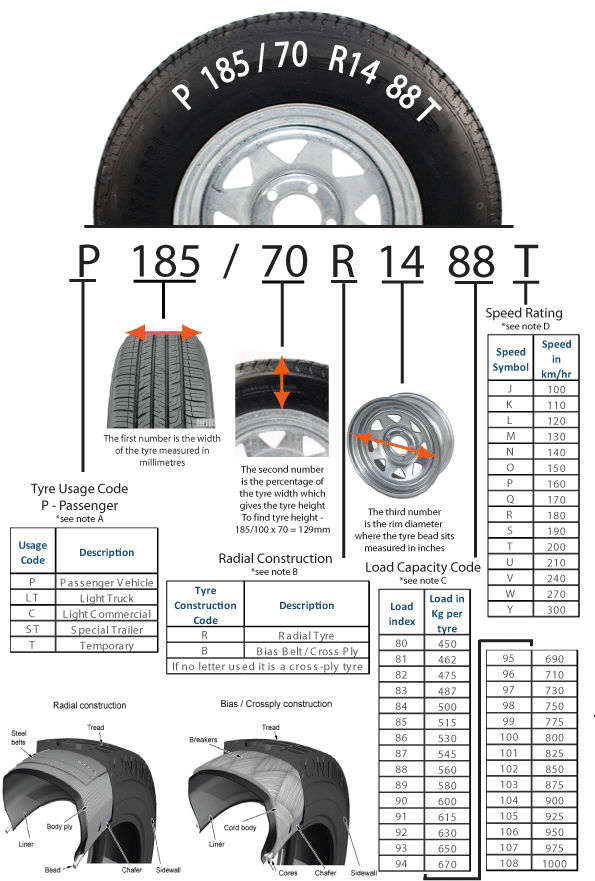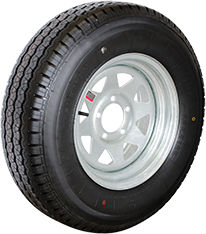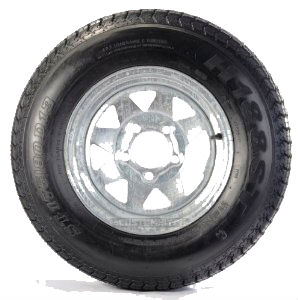Trailer Tires
Tires give your trailer more than just a comfortable ride, they add stability and traction to the trailer and ensures that it is responsive to the towing vehicles actions.
Getting the right tire for your trailer is as important as all the other components that make up your trailer.
Looking at a tire sidewall will give most people a sense of bewilderment with all the letters, numbers and codes. Knowing how to read a tire sidewall can assist you in determining the correct tires for your new or existing trailer.

Tire Sizing
Tire specifications are on the whole measured on the metric system. For conversion of millimeters (mm) to inches - 1" = 25.4 mm. To convert Kilograms (kg) to pounds (lbs) multiply kg x 2.2 - 1 kg = 2.2 lb
The first designated number on the tire is the usable width of the tire tread and is measured in millimeters (mm), the second number is the aspect ratio or profile of the tire and is a percentage of the tyre width. For example a 185/70 R14 tire has a tread width of 185 mm and 65% of this is 129.5 mm (185 divided by 100 = 1.85 x 70 = 129.5 mm).
Light Truck tires or Commercial tires sometimes do not include the aspect ratio number on the tire, for example - 185R14C. With these tires the manufacturers have adapted a standard aspect ratio of 82%, so for 185R14C tire the side wall height will be 151.7 mm
A - Tire Usage Code
The way a tire is constructed determines the usage code. A passenger vehicle tire will normally have a lower profile than the other coded tires (except the Temporary tire) and will have a more flexible sidewall to give a softer ride to the driver and passengers. Tread patterns will also be vastly different to allow the tire to operate in most road conditions at high speeds as well as to help reduce road noise. P code tires have higher speed ratings than all other codes. Depending on the manufacturer, some passenger tires may not specify a usage code.
P code tires are suitable for single axle trailers up to 2000 lb GTW as long as the tire load rating matches the trailers loaded weight.

LT or Light Truck tires are built for load carrying capacity at lower speeds than the P code and are normally 6 to 8 ply. Some manufacturers call these tires "Commercial" or "Light Commercial" and will have a "C" branded on the tire, normally after the tire size. These are effectively the same as a Light Truck tire. They have heavier constructed sidewalls and thicker, more pronounced tread patterns. These are suitable to fit to single axle and tandem axle trailers over the 2000 lb GTW as long as the tire load rating matches the trailers loaded weight. ST tires are recommended over LT and Commercial tires.
ST or Special Trailer tires are constructed to have larger and stronger polyester and steel cords within the sidewalls and tread giving them the ability to handle higher load capacities and their additional sidewall stiffness reduces the potential of trailer sway. ST tires are rated to be driven at 65 mph at their recommended tire pressure, although if the cold inflation pressure is increased by 10 psi, some brands of ST tires can be towed at up to 75 mph. ST tires are strongly recommended for trailers with a GTW of 2000 lb or more.
T or Temporary tires are specifically for use as space saving spare wheels and should never be used on a trailer.
B - Tire Construction
The process of constructing a tire varies considerably between bias and radial tires and the end result creates vastly different tire characteristics, some of which can compliment a trailer and its load and some that can be restrictive in their use.
Bias/Cross ply
Bias or cross ply tires are built with cord plies wrapped in an overlapping diagonal direction around the tire in a continuous X fashion, hence the name cross ply.
This cross hatching provides very strong sidewalls which provides excellent stability to a loaded trailer but due to the inflexibility of the tread area, tires tend to wear out quite quickly.
Bias tires tend to hold the heat they generate and will run hotter under load. This is not really an issue if you are using your trailer for short distances. For long haul towing, radial tires would be your better choice.
Radial
Radial tires are built using steel belts running around the tire below the tread, which allows the sidewall to have some flexibility. With correct tire pressures, radial tires give better traction and a more stable ride, especially if your towing involves a lot of cornering, as more of the tire tread is in contact with the road.
The steel belts within the tire tend to dissipate heat, keeping the tires cooler which in turn gives the tires a longer life expectancy.
Choosing which tire to use really comes down to end use. For intermittent, short distance, straight road hauling, a bias tire would be the better choice. For everyday hauling where distances and road conditions vary, radials would be my pick.
If cost is an issue, bias tires are cheaper, although their life expectancy is not as good as radials.
C - Load Capacity Code
Each tire model has its own maximum load capacity at its recommended tire pressure. This number is very important in deciding the correct tires for your trailer. For safety's sake I would be inclined to add at least 10% extra loading on your tires. For example, if you had a single axle trailer with a GTW of 2200 lb, add an extra 10% - 2420 lb and find a tire with an 88 or above load rating (1230 lb or 560kg per tire).
Tire Pressures
Remember to always keep your tires at the recommended pressures. Tires with below the recommended tire pressure will heat up and get hotter quicker than tires with the correct pressure (The motion of the tire sidewalls flexing up/down and side to side create internal friction of which heat is a by-product). Tire overheating is increased even further if the trailer is overloaded. It is a common occurrence for tires which get too hot, to rapidly degrade and blow out, and it is one of the most common reasons for tire failure especially with tires with a heavier sidewall. The thicker the sidewall, the more heat is generated.
 Reduced tire pressures also increase the chance of instability of your trailer. If for whatever reason your trailer decides to fishtail or sway excessively,(normally due to an unbalanced load), tires with low or uneven tire pressures can exacerbate the situation to the point where it is almost impossible to bring the trailer under control safely.
Reduced tire pressures also increase the chance of instability of your trailer. If for whatever reason your trailer decides to fishtail or sway excessively,(normally due to an unbalanced load), tires with low or uneven tire pressures can exacerbate the situation to the point where it is almost impossible to bring the trailer under control safely.
Tubed tires will also generate a lot of friction induced heat within the tire and are not recommended.
The best way to prevent tire damage and increase their life span is to check and maintain your tire pressures on a regular basis. A tire does not need to look flat to be under inflated and only check the pressures when the tire is cold.
D - Speed Rating
The tire speed rating is based on the manufacturer machine testing the tire at the rated speed for 10 consecutive minutes without flying apart, disintegrating and generally staying in one piece.
There is so much information on a tire sidewall that there are plenty of websites dedicated to deciphering them.
The bottom line with trailer tires is pick a common sized tire from a trusted source, get their advice, check that it will carry the trailer and its maximum load comfortably and safely, check that it will fit the wheels you want, keep an eye on the tire pressures on a regular basis and get a spare tire while you are at it.